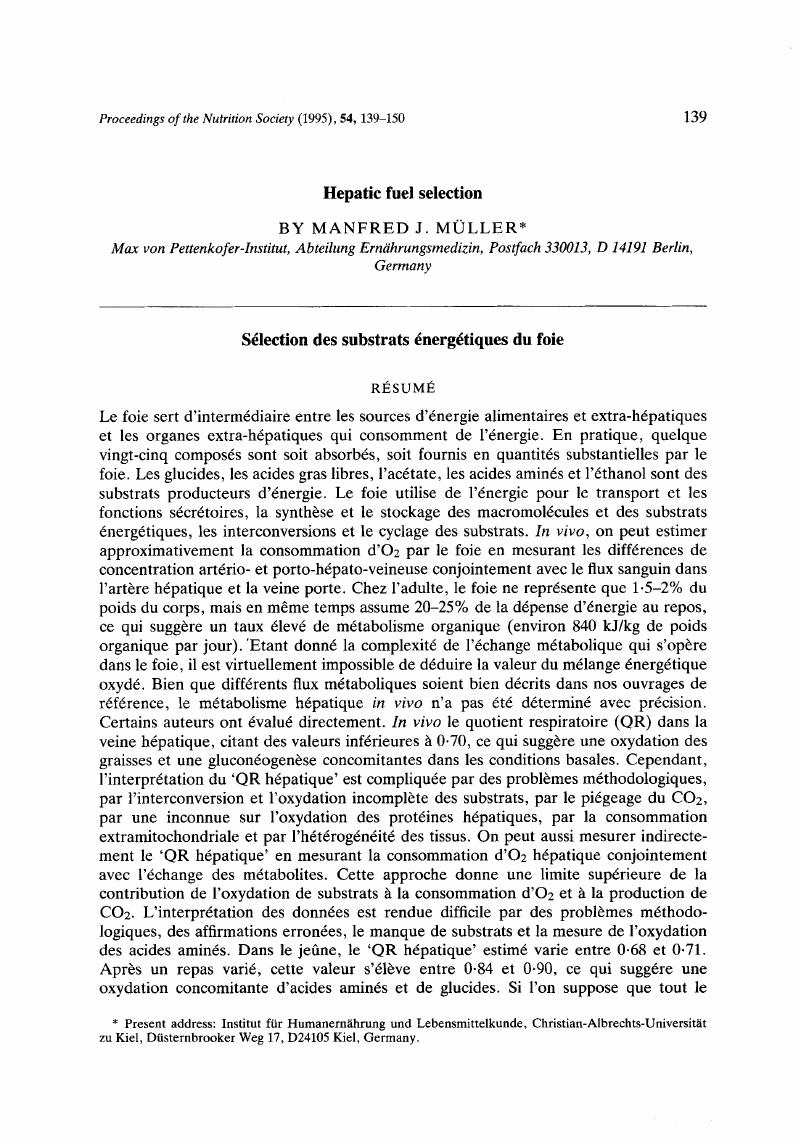Crossref Citations
This article has been cited by the following publications. This list is generated based on data provided by Crossref.
Müller, M.J.
1997.
On the impact of the metabolic state in cirrhotic patients.
Nutrition,
Vol. 13,
Issue. 7-8,
p.
687.
Müller, Manfred James
1998.
Hepatic Energy and Substrate Metabolism: A Possible Metabolic Basis for Early Nutritional Support in Cirrhotic Patients.
Nutrition,
Vol. 14,
Issue. 1,
p.
30.
Friedman, Mark I.
Harris, Ruth B.
Ji, Hong
Ramirez, Israel
and
Tordoff, Michael G.
1999.
Fatty acid oxidation affects food intake by altering hepatic energy status.
American Journal of Physiology-Regulatory, Integrative and Comparative Physiology,
Vol. 276,
Issue. 4,
p.
R1046.
Flatt, J. P.
1999.
Metabolism and Artificial Nutrition in the Critically Ill.
p.
29.
Simonsen, Lene
Coker, Robert
A. L. Mulla, Nariman
Kjær, Michael
and
Bülow, Jens
2002.
The effect of insulin and glucagon on splanchnic oxygen consumption.
Liver,
Vol. 22,
Issue. 6,
p.
459.
Hannukainen, Jarna C.
Nuutila, Pirjo
Ronald, Borra
Kaprio, Jaakko
Kujala, Urho M.
Janatuinen, Tuula
Heinonen, Olli J.
Kapanen, Jukka
Viljanen, Tapio
Haaparanta, Merja
Rönnemaa, Tapani
Parkkola, Riitta
Knuuti, Juhani
and
Kalliokoski, Kari K.
2007.
Increased physical activity decreases hepatic free fatty acid uptake: a study in human monozygotic twins.
The Journal of Physiology,
Vol. 578,
Issue. 1,
p.
347.
Fülöp, Péter
and
Paragh, György
2010.
Patomechanisms of hepatic steatosis.
Orvosi Hetilap,
Vol. 151,
Issue. 9,
p.
323.
Fabbrini, Elisa
Sullivan, Shelby
and
Klein, Samuel
2010.
Obesity and Nonalcoholic Fatty Liver Disease: Biochemical, Metabolic, and Clinical Implications.
Hepatology,
Vol. 51,
Issue. 2,
p.
679.
Gam, C. M. B.
Nielsen, H. B.
Secher, N. H.
Larsen, F. S.
Ott, P.
and
Quistorff, B.
2011.
In cirrhotic patients reduced muscle strength is unrelated to muscle capacity for ATP turnover suggesting a central limitation.
Clinical Physiology and Functional Imaging,
Vol. 31,
Issue. 3,
p.
169.
Fabbrini, Elisa
and
Magkos, Faidon
2014.
Treatment of the Obese Patient.
p.
121.
Heinonen, Ilkka
Kalliokoski, Kari K.
Hannukainen, Jarna C.
Duncker, Dirk J.
Nuutila, Pirjo
and
Knuuti, Juhani
2014.
Organ-Specific Physiological Responses to Acute Physical Exercise and Long-Term Training in Humans.
Physiology,
Vol. 29,
Issue. 6,
p.
421.
Fabbrini, Elisa
and
Magkos, Faidon
2014.
Treatment of the Obese Patient.
p.
121.
Müller, Manfred J.
Geisler, Corinna
Hübers, Mark
Pourhassan, Maryam
Braun, Wiebke
and
Bosy-Westphal, Anja
2018.
Normalizing resting energy expenditure across the life course in humans: challenges and hopes.
European Journal of Clinical Nutrition,
Vol. 72,
Issue. 5,
p.
628.
Green, Charlotte J
Pramfalk, Camilla
Charlton, Catriona A
Gunn, Pippa J
Cornfield, Thomas
Pavlides, Michael
Karpe, Fredrik
and
Hodson, Leanne
2020.
Hepatic de novo lipogenesis is suppressed and fat oxidation is increased by omega-3 fatty acids at the expense of glucose metabolism.
BMJ Open Diabetes Research & Care,
Vol. 8,
Issue. 1,
p.
e000871.
Worley, Beth L.
Auen, Thomas
Arnold, Amy C.
Monia, Brett P.
Hempel, Nadine
and
Czyzyk, Traci A.
2021.
Antisense oligonucleotide‐mediated knockdown ofMpzl3attenuates the negative metabolic effects of diet‐induced obesity in mice.
Physiological Reports,
Vol. 9,
Issue. 9,
Hong, Ting
Chen, Yiyan
Li, Xiaoying
Lu, Yan
and
Pu, Jun
2021.
The Role and Mechanism of Oxidative Stress and Nuclear Receptors in the Development of NAFLD.
Oxidative Medicine and Cellular Longevity,
Vol. 2021,
Issue. 1,
Müller, Manfred J.
2023.
Being a scientist.
European Journal of Clinical Nutrition,
Vol. 77,
Issue. 6,
p.
615.
Bartman, Caroline R.
Weilandt, Daniel R.
Shen, Yihui
Lee, Won Dong
Han, Yujiao
TeSlaa, Tara
Jankowski, Connor S. R.
Samarah, Laith
Park, Noel R.
da Silva-Diz, Victoria
Aleksandrova, Maya
Gultekin, Yetis
Marishta, Argit
Wang, Lin
Yang, Lifeng
Roichman, Asael
Bhatt, Vrushank
Lan, Taijin
Hu, Zhixian
Xing, Xi
Lu, Wenyun
Davidson, Shawn
Wühr, Martin
Vander Heiden, Matthew G.
Herranz, Daniel
Guo, Jessie Yanxiang
Kang, Yibin
and
Rabinowitz, Joshua D.
2023.
Slow TCA flux and ATP production in primary solid tumours but not metastases.
Nature,
Vol. 614,
Issue. 7947,
p.
349.
Srnic, Nikola
Dearlove, David
Johnson, Elspeth
MacLeod, Cameron
Krupa, Antoni
McGonnell, Alice
Frazer-Morris, Charlotte
O'Rourke, Paige
Parry, Sion
and
Hodson, Leanne
2024.
Greater oxidation of dietary linoleate compared to palmitate in humans following an acute high-carbohydrate diet.
Clinical Nutrition,
Vol. 43,
Issue. 10,
p.
2305.



